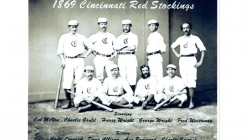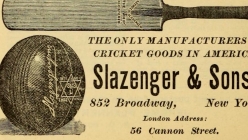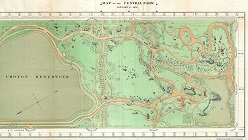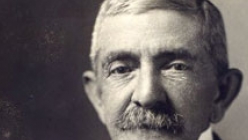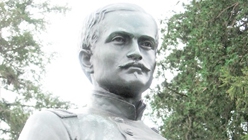History of American Cricket Part III - 1850's
2007 Sep 11 by DreamCricket USA
By 1850 at least twenty organizations in more than a dozen American communities fielded elevens, enrolling perhaps five hundred active players. During the next decade English immigrants and natives promoted cricket throughout the country. With the help of New York City sporting periodicals and local newspapers, they scheduled intercity and international matches.
Part III of our multi-part series on USA Cricket History
History of American cricket Part I - The 1700's
History of American Cricket Part II - 1800 to 1850
1850s: American Cricket’s Golden Era
By 1850 at least twenty organizations in more than a dozen American communities fielded elevens, enrolling perhaps five hundred active players. During the next decade English immigrants and natives promoted cricket throughout the country. With the help of New York City sporting periodicals and local newspapers, they scheduled intercity and international matches.
covered cricket.
As the decade drew to a close, cricket was played in at least twenty-two states and more than one hundred twenty-five cities and towns across America. Porter’s Spirit of the Times estimated the number of clubs at nearly one thousand in the late 1850s. Although there were periods of lower activity, in 1860, it was estimated that some ten thousand Americans had played the sport for at least a year.
When Chicago hosted Milwaukee in a 1859 cricket match, Abraham Lincoln was among the spectators. That’s right. George Bush Junior was not the first President to try his hand at cricket.
In 1859 Porter’s Spirit of the Times claimed that about six thousand cricketers lived within one hundred miles of New York City, including Philadelphia. Whereas Manhattan, Staten Island, Brooklyn, and adjacent Long Island had at least twelve clubs by 1860, Philadelphia had clearly established itself as the cricketing capital of the nation, with 120 clubs. Add to that the fact that Philadelphia had the largest contingent of American born players, this city completely deserved the title of “cradle of cricket in USA.”
Several graduates of the University of Pennsylvania who had played cricket with the Junior Club were among the founders of the Philadelphia Cricket Club in 1854. Since these cricketers were influential, and were also great organizers, they managed to provide a great platform for cricket in Philadelphia.
The major Philadelphia cricket clubs of the time were Germantown CC, formerly the Manheim CC(1854) and Philadelphia CC (1854). Union Cricket Club had been in existence for some years. The famous Merion CC (1865) and Belmont CC (1874-1913) followed later. Enough momentum was achieved in this decade that cricket could be kept alive in this region all the way until the First World War. During this time, the city produced many of America's greatest cricketers - including the famous Newhall family (Robert bowled the great W.G. Grace in the first ball and was immediately presented with Grace’s bat which is now in the CC Morris Library at Haverford College).
These great cricketers established Philly’s supremacy in cricket which was kept up into the 20th century. Bart King, who led England’s bowling averages in 1908, started playing cricket as a child in the 1870s. Percy Clark was Bart's bowling partner, Henry Scattergood, an outstanding wicket keeper, John Lester the great Haverford College cricketer and Christy Morris another great Haverford and Philadelphia player, all followed in the footsteps of the Newhall brothers.
The sport also had a following in Boston and in the factory towns of New England, and had by now spread to southern towns as Baltimore, Savannah, and New Orleans. Chicago, Cleveland, Cincinnati, Milwaukee, and even San Francisco and nearly twenty other cities and towns in the West also fielded teams. The earliest references to cricket in Seattle and the Pacific Northwest come from about 1850. In Portland (Oregon), a treasure trove of early records have been unearthed by Kerry Jeffries of the Multnomah Cricket Club.
With growing popularity came the problems, some that are cricket’s affliction even today. Poor grounds, betting scandals, umpiring disputes, and let us not forget the many organizational inadequacies.
Among the many firsts celebrated during this decade was the first ever overseas cricket tour. England played five matches on this tour during the Fall of 1859. An event whose 150th anniversary is around the corner. MCC has planned a tour to commemorate this first overseas tour.
What was cricket like in the mid-19th century?
Even though America saw more cricket being played in the second half of the 19th century, and cricket was the American sport to watch, the conditions were vastly different from what we are used to seeing in cricket today and comparisons of the scores from that era to today’s scores cannot be made.
The grounds were badly kept and were of poor quality, a problem that continues to plague American cricket, and the scoring consequently very low. There were three or four grounds in America that were top-notch. That is perhaps more than we have today.
Where there is cricket, there shall be gambling!!
Gambling was very common and many wickets fell due to gambling. Back then, 90 was a decent score and many sides fell for half of that. Centuries were rare if not unknown and double figures were celebrated.
Why did these Englishmen and native Americans play cricket?
An enthusiast from Philadelphia gave part of the answer in 1859: “Look at the cricketers in their loose fitting, comfortable uniforms, their faces beaming with, good humor and ruddy health, engendered by exercise. Note the eager anxiety of the fielders, their mortification at an overthrow, or a chance for a catch not taken advantage of; see the high ascending ball, and hear the joyous shout of the triumph, as some unfortunate batsman gets permission to retire to the tent, and if you do not leave the ground impressed with the beauty and the utility of the game, why then-you were not cut out for a cricketer.” Once bitten by the cricket bug, those addicted devoted countless hours to its pleasures and pain.
Thomas Dodworth, speaking at the twenty-first anniversary dinner of the St. George club, proposed his own epitaph:
“Bowled out by death,
here lies old Doddy,
A cricketer both soul and body,
Who hoped he’d cricket find in Heaven,
That he might join some good eleven.”
According to the Times, native sportsmen deserved the credit for the Philadelphia cricket boom, while the Englishmen who dominated the sport in Manhattan had “almost utterly squelched the rising spirit of cricket amongst Americans in New York, and driven it into base-ball, as a means of out-door exercise and recreation.”
Nationality was a more important factor in the formation of early American cricket clubs than it was for baseball organizations. The Philadelphia. New York, and St. George clubs were primarily British at heart. In the 1850’s and 1860’s, more native Americans were admitted. But there was a resentment of the British tendency to monopolize play. Several clubs were formed in the Philadelphia vicinity, including the Germantown, Young America. and Union, which restricted their membership to men born in the United States. Brooklyn’s short-lived American Cricket Club, founded in 1860, is an interesting example of this type.
It was organized by several prominent Brooklyn baseball and cricket players, and its goal was to promote England’s national pastime among Americans by ‘revolutionizing the mode in which it had been hitherto governed in this country.” It began its brief existence with forty enrolled and a successful inaugural season, but the outbreak of the Civil War weakened the American Cricket Club as it did to a lot of the sporting activity in the country. More of that when we visit 1860’s.
Here is the timeline for American cricketing events during 1850s.
August 24-25, 1853: USA vs Canada in New York
The USA vs Canada contests date back to 1844 and the first three were won by Canada. There was a temporary suspension but cricketing ties resumed in 1853.
The amateurs assembled in full force on August 24, 1853 at the cricket ground of St. George’s Club, Red House, 3rd Avenue, anxious to witness the Canadians play the US. USA won the toss and took to bat. Umpires were Sam Nicholls of Sunday Mercury for US and Mr Barber for Canadians.
Betting was in full swing and the Canadians offered to bet five to four on the result. They even bet on a first innings lead.
USA scored 62 in their first innings and then proceeded to bowl. During the luncheon break, the Canadians were still posting even bets. The Americans bowled extremely well and the Canadians were unable to make runs. Canada’s first innings score of 45 gave the Americans a decent lead of 17. Betting died down after this as Canadians lost confidence.
The Americans began their second innings at 4:40PM. The chances of winning were decidedly in favor of USA at the end of Day 1 with the score at 46 for 5.
On day 2, the attendance at the Red House was more than the previous day. The backers of Canadians were cautious. No more $10 to $5 were offered. Even those who would bet even and take Canadians for choice were not that many.
Blackburn went in to bat with Fletcher. Fletcher made an impressive 19 runs taking USA to an impressive second innings score of 71. Sam Wright had scored 22 runs in USA’s first innings. He added another 12 in the second.
That left Canada with 89 to win, a difficult task that Bradbury confidently set out to score but when he fell with his personal score at 13, not much remained for the Canadians in the game and they collapsed for 54.
The US were therefore the winners by 34 runs. Both teams returned to town together in good humor. The Sporting Intelligence reporter called it the “most severely contested match on the continent.”
Here is what we could unearth by way of scorecards for this game.
USA First Innings:
Sharp b Napier..3
Blackburn b Bradbury..5
Dockery c Donne..11
Sam Wright b Parsons..22
Marsh b Napier..4
R Walter run out..5
Fletcher b Parsons..3
Connery c Farmer b Parsons..2
Wilson..0
Burnett..0
Cuyp..0
Burnett not out..0
Byes and wides…7
Total..62
Canada First Innings
Howard b Connery..5
Parsons b Connery..0
Napier b Cuyp..0
Donne c Dockery b Conery ..5
Pickering b Conery..15
Bradbury b Conery..15
Capt Gallway lbw Cuyp..9
Farmer b Cuyp..2
Capt Keane run out..2
Phillpots b Conery..0
Stanley not out…0
Wides and Byes..7
Total..45
USA Second Innings:
Sharp run out Parsons..11
Blackburn not out..12
Dockery cNapier b Bradbury..5
Sam Wright run out Pickering..12
Marsh c Napier b Pickering..2
Waller b ..1
Blackburn b Bradbury..12
Fletcher c Howard b Parsons..19
Conery b Parsons..1
Burnett not out..2
Wilson..0
Cuyp..0
Total..71
Canada Second Innings:
Howard c Wright b Conery..1
Bradbury c Marsh b Conery..13
Stanley b Conery..4
Donne c Marsh b Conery..1
Pickering b Marsh..0
Napier b Marsh..3
Parsons b Conery..7
Capt Keane b Marsh..5
Capt Gallway c Marsh b Conery..1
Farmer b Conery..5
Phillpots not out..2
Stanley b Marsh..4
Wides, Byes, Leg byes..12
Total..54
1854: On the international front, fast bowler Joel Bradbury of the Toronto Cricket club captured 9 wickets for 6 runs to skittle the United States for 32 runs at Toronto in 1854. to the present time this is still the lowest innings total in the international series by the United States against Canada. For over 150 years Bradbury?s first name and bowling analysis remained a mystery until discovered by American cricket historian, David Creeth in 1996. Bradbury played for Canada on three occasions but old records indicate he suffered from poor health and he quickly disappeared from the international scene.
1855: The Young America club of Germantown originated as a junior club in 1855, when the older boys in town excluded anyone under the age of sixteen from their ranks. The youngsters started their own club that grew into one of the premier outfits in American cricket.
1856: About 1856 the idea of a visit from an England XI came up but fell through after the great industrial depression. England had never toured anywhere at this point.
1856: Cricketers were starting to be drawn from various professions around this time.
On July 4, 1856, a few mechanics of the Ogdensburgh Railroad founded a cricket club at Rouse’s Point, New York, composed mostly of Americans. Called The New Brighton Mechanics Club initially, the name was changed to Staten Island Cricket Club in 1858 to avoid confusion with the white collar New Brighton Cricket Club. This club exists to this day.
In 1857 the United of Waltham, Masachusetts was “composed chiefly of operatives, the thew and sinew of our land, in whom is found the wealth and prosperity of the nation.” The “Shoemakers” Cricket Club in 1859 was composed of exactly that in Berlin, Massachusetts.
Some 30 printers at daily newspapers around Philadelphia formed the Typographical Cricket Club in 1858. In Newark, skilled artisans, especially jewelers, silver platers, and tailors, played for the three main cricket clubs - the Newark, Mechanics, and Essex clubs.
1856: After seeing spectator interest in the USA vs Canada matches of 1856, WP Pickering of Canada mooted the idea of an English tour of North America. When Robert Waller of St. George got involved with this idea, a tour was finalized in 1859.
1857: America’s first cricket dispute
Although the leading clubs tried to maintain good relations, in several notorious cases referees’ judgments produced much ill will.
Perhaps the biggest cricket feud in America resulted from an 1857 match between the New York and St. George’s elevens. The New York Cricket Club was forty-four runs behind with only one wicket remaining, when its captain refused to permit his last player to bat because of a six o’clock curfew in effect at that time. But the umpire decided that the contest should continue.
The New York side withdrew from the ground refusing to concede defeat. The clubs then appealed for a decision to the foremost sporting journal of England ‘Bell’s Life in London.’
to Bell’s Life
The acrimonious battle spilled into the pages of their supporting publications. The two captains argued their positions in the pages of Porter’s Spirit of the Times (supporting New York) and the Clipper (supporting St. George’s).
In February, 1858 a prominent observer of the New York cricket scene, William N. Bradshaw, tried to persuade “those two excellent clubs to do away with this painful exhibition of animosity” reminding the clubs that cricket was a “noble exercise” and expressing hope “that each party will let honor, integrity, and friendship unite them to form two active and respectable links of society.”
In the summer of 1859 the two rivals agreed to a binding arbitration by a third party in Albany who ruled in favor of St. George’s.
The New Yorkers finally conceded but in 1860 they refused to play at the Dragon-Slayers’ new enclosed ground, blaming the ten cent admission charge. It was not until 1865 that the clubs resumed their first elevens series.
November 11, 1858: Cricket is central to Central Park
On November 11, The New York Times reported that the construction of Central Park in Manhattan was progressing nicely. Cricket was central to the plans for Central Park.
“On the southern end, where the grand Promenade or the Cathedral Walk is laid out, the work is in advanced stage. West of the Cathedral Walk, the cricket and baseball ground, which has very properly been first attended to, as it will be the most beneficial to the public, has been leveled and is ready to be laid down in turf. This piece of the park, 14 acres of it, will be in order next spring when the Grand Promenade with the Terrace and the steps leading to the lake will also be finished.”
“More than 12 months labor of nearly three thousand men on an inclosure of less than eight hundred acres should produce some very marked results. A system of drainage was adopted, roads laid out and the foundations laid for the erection of the future superstructure which is to endure for centuries and be the play grounds of the great grandchildren of the present generation. 7 miles of stone wall has been built but it is not very imposing in its presence because only a small portion of it is seen at a time.”
“The 15 miles of earthen drainage pipes make no show whatever – they are 10 to 15 feet below the surface of the ground.”
“The laborers are allowed 45 mts for dinner and are summoned to work by ringing the great bell. They receive 90 cents a day for nine hours of work. Superintendents are paid 1.75 for the same duration. Expenditure for labor is in the range of $1000 a day. On the Upper Reservoir, there are another 1200 employed for more hours of work. Altogether, there are 4000 men at work within the inclosure of the park.”
1859: Employers were giving time off to their employees to play cricket. In 1859 the employees of Philadelphia’s Landberger and Co. competed against men from Germantown’s Spencer and Co.
1859: When Chicago hosted Milwaukee in a 1859 cricket match, Abraham Lincoln was among the spectators.
September 6, 1859
First Ever English Tour
Robert Waller of New York guaranteed GBP 500 for two matches in the USA and on September 6th 1859, twelve professional cricketers of England met at the George Hotel, Liverpool and left the English shores via the Nova Scotian the next morning. The team comprised Caffyn, Lockyer, HH Stephenson, Julius Ceasar (of Surrey), Parr, Grundy and Jackson (of Nottinghamshire, John Wisden and John Lillywhite (Sussex), Carpenter, Tom Hayward and Diver (Cambridgeshire), with Fred Lillywhite acting as the manager.
England vs Canada: Match report from September 24-26, 1859
The English team stopped in Canada en route to USA. On their voyage from Liverpool to Quebec City on board “Nova Scotian,” the Englishmen feared for their lives as storms raged in the Atlantic. In Canada, even though the tourists were far too strong for the locals, the visit was a great success, becoming the first English cricket ‘tour’ in history.
Their first match on the tour was played at Montreal against 22 Gentlemen of Lower Canada on September 24-26. A crowd of 3,000 roared their approval. Sporting tours became a way of life with this event.
The tour also marked several important publishing milestones for cricket. And playing on the English team were two visionary pioneer cricket writers and publishers of the era (John Wisden and Fred Lillywhite).
Fred Lillywhite, true to form, wrote a fascinating book describing the adventure titled “The English Cricketers Trip to Canada and the United States?”
“Nobody talks or writes or dreams of anything but cricket. Bats are discussed at breakfast as freely as beefsteaks and balls at dinner as if they are eatable,” wrote the reporter for The Times. “Philadelphians jostle Chicagonians, New Orleanists, NewYorkers, Englishmen shake hands with Canadian French and even the phlegmatic Dutch turn out spiritedly.” Leslie’s Illustrated reported that people who were as ignorant of cricket as they were of the social life of the Chinese were now discussing ‘no balls’ and ‘cuts.’
The English team did well financially earning over $5000 from the tour. The organizers profited from the tour as well. In New York, St. George Cricket Club reported gate receipts of about $2000 on the first day itself. Total expenses for the three days was roughly $3200, so it can safely be assumed that the club made a hefty profit.
“The Eleven do not bet, at least openly, but outsiders do. The bets are that two to one English Eleven will win any one of the four matches named. Even bets that they will win all four. Even bets that there will be 8 ducks in the Twenty Two’s batting. Varying wagers on one man’s score against the other. The most animated betting is on the NY match. The Americans back the US to win and the rest bet that English will win easily.”
The English team was composed of men from All England and the United All England Clubs. These two were the main national teams for England and had won four matches each in the prior year.
The Montreal ground has eight acres of ground to play on not counting adjacent land. Grundy, the oldest English player is just 26. Everyone is quite young and short with average height in 5 ft 5inch range.
At 12:15 the match commenced the twenty two sent to bat. Canadians were disposed off by 5 PM for a meager 85 runs. Daly alone accounted for 19 of those runs. Capt Webber Smith scored 9. The rest did very little. Mr Pickering who got 8 did not get those fairly. Since he was the Secretary of the Montreal Cricket Club, he was given an easy life when the first ball he hit landed in the safe hands of Parr. Parr, who knew a thing or two about how hard it is to organize a visiting eleven, tossed the ball from one hand to the next and let it drop. Then Caffyn and Jackson sent some easy ones in which to score and finally put a stop to Pickering. Jackson who was known to be the fastest bowler in the world was a tricky one. His average speed was not much more than Hallis but his varying of speed was difficult to stand. “Once in a while, he sends a canon shot which rarely rises above the wicket but comes at you straight like an arrow,” reported the Times reporter.
The English played for the remaining time. They were 7 for the loss of Grundy’s wicket when the day ended.
Stands were built to accommodate a large number of spectators. Lillywhite had a tent to sell cricket cards. A tent for refreshments was also erected. The Times reporter wrote, “The caterer could not have been chosen for worse food for which he charged - 62.5 cents for each victim, who was compelled to take it or nothing.”
Here is what we could unearth by way of the proceedings of this important match.
First innings of the Canadian Twenty Two
Swain b Caffyn..4
Lieut Surman c Caffyn b Jackson..4
Lieut Symons c Jackson b Caffyn..2
Lieut Honner b Jackson..0
Fisher lbw b Jackson..0
Foudrinier c Caasar b Jackson..6
Hardinge b Caffyn..0
Ravenhill c Jackson b Caffyn..2
Capt Earle run out..4
Pickering b Caffyn..8
Capt King b Jackson..3
Daly b Parr..19
Webber Smith b Jackson..8
G Bacon run out..4
Morgan c Wisden b Stephenson..0
Swettenham b Parr..3
JU Smith c Stephenson b Parr..6
Napier st Lockyer b Parr..0
Ellis b Parr..2
Prior b Jackson..3
Tilstone hit wicket b Parr..0
Kerr not out..1
Byes and Leg byes..6
Total..85
After the match the members of the Montreal Cricket Club entertained the English players and other guests at the St. Lawrence Hall. President Johnston proposed a toast to the seventy persons in attendance to which Parr responded.
Day 2 as it happened
The English eleven made 110 in their first innings. The Canadians did not do as well in the second innings as they did in the first posting just 63 with Smith top-scoring with 17.
The eleven needed 39 runs to win and reached that score for the loss of just two wickets. Hayward scored 17 and Lockyer 10. Caffyn on 4 and Diver on 1 were the not out batsmen.
October 3-5, 1859: England vs USA: Match report
The first game of the USA leg took place between the English and the XXII of the USA at the Elysian Fields, Hoboken, NJ on October 3rd, 4th and 5th of 1859.
This match is preserved for posterity thanks to the images published on October 15, 1859, in the Harper’s Weekly. The images portray two different ball games being played on the same day at the Elysian Fields in Hoboken, New Jersey. An American cricket team is shown playing the British one on the left hand side. A baseball game is in progress on the same ground on the right hand side.
.jpg)
This tour had acquired enormous prestige and representatives from far flung cities traveled long distances to meet with the English side nurturing hopes of having the English side visit their cities.
Cincinnati Cricket Club representatives went all the way to Montreal and promised 75% of the gate receipts if the English side played there. Albany, St. Louis, Baltimore, all tried to persuade the English side to visit their cities and play their local teams. In fact, an unscheduled stop was made at Rochester by the English side after Rochester Mayor announced $1500 of public funds for improving the city’s cricket ground and took a personal interest in the match.
This match was played at the Elysian Fields which got a $2000 makeover thanks to the timely help from Edward Stevens. Local clubs pitched their tents (giving rise to the expression ‘tented field’). “The largest array of spectators” turned up, way beyond the organizers’ expectations. The English players encountered 8000 spectators on the first day and this number doubles on the second day. In total, some 25,000 spectators watched the game on the three days.
England scored 156 and USA XXII scored 38 and 54. Fielding 22 in a side was not unusual those days and Australians did the same thing against England with cricket in USA being more advanced than Australia at that stage.
New York’s cricketing skills were embarrassing and it was defeated by a huge margin.
Some said that the American team was not truly a representative one. Most on the team were English residents of New York and there were just three Philadelphians on the American team – Walter Newhall, Charles Barclay and William Morgan.
Criticism was focused on the selection of Waller, Walsh and Comery, who were veterans of the USA vs Canada series a decade and half earlier.
October 12-15, 1859. England vs USA: Match report
In the second match at Philadelphia, which began on October 12th, on the Camac Estate at 13th and Columbia Avenue, the XXII scored 94 and 60 with England scoring 126 and 29 for three to wrap up the match.
This match was closer than the New York one and some of the American pride was redeemed. Thus the series ended with a huge victory for England.
Lillywhite wrote, “the ground presented a most animated appearance. We never saw such a magnificent sight; about 1,000 ladies were sitting by themselves, and they appeared to be enthusiastic.”
First international umpiring controversy
The tour saw the first international controversy in Philadelphia when Henry Sharp inexplicably called a wide when English player Robert Carpenter was caught. Carpenter made 22 decisive runs for his side. Jones Wister claimed that it had cost Americans the match.
Here is a short summary of the tour:
Englishmen defeated XXII of Lower Canada by 8 wickets at Montreal, Quebec on 26-27 September
Englishmen defeated XXII of the United States by an innings and 64 runs at Hoboken, New York State on 3-5 October
Englishmen defeated XXII of the United States by 7 wickets at Philadelphia on 10-12 October
Englishmen defeated XXII of Lower Canada by 10 wickets at Hamilton, Ontario on 17-19 October
Englishmen defeated XXII of the United States by an innings and 68 runs at Rochester, New York on 21-25 October.
The English side was of course exceedingly strong and would probably have beaten any XXII in England. There were excellent crowds for the first three matches but the weather in mid-October turned very cold and reduced the attendances at the last two. It was reported that the fielders wore gloves and overcoats in the last match.
Coming Next: Cricket in the 1860's - Influence of the Civil War.
Picture and archive credits: Not a word on USA cricket can be written without acknowledging Tom Melville, P David Sentance, Amar Singh, and Deb Das. We are grateful to them for their terrific books and/or articles which provide in-depth and insightful commentary. What we have done here is merely constructed a timeline. Also fascinating are the rich histories available via UPenn and Haverford + Bryn Mawr Archives.
Most of all, we relied on NY Times archives as well as our own collection of books and magazines that we were fortunate to obtain when the KA Auty Library was auctioned off by the Ridley College in Ontario.
We depended on New England colleges for history of college cricket, especially Yale, Dartmouth, and Harvard archives. Of course, Wikipedia is among the most extensive sources these days. Pictures are presumed to be out of copyright owing to their antiquity.
